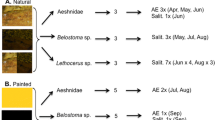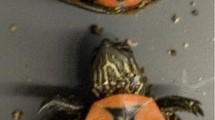Abstract
Although many organisms show multiple types of trait responses to predation risk (e.g., shifts in behavior, morphology, color, chemistry or life history), relatively few studies have examined how prey integrate these multiple responses. We studied the joint expression of color and behavioral responses to predation risk in two sister species of salamander larvae that live in habitats with different selection pressures. We examined responses to predation risk in three situations that differed in availability of refuge and substrate color heterogeneity, and thus availability of behavioral options for reducing risk. Relative to Ambystoma texanum, A. barbouri larvae were darker in color and showed a greater range of color change. With no variation in background color or refuge available, both species exhibited color change to better match the available background. The degree of color change showed by both species, however, did not depend on predation risk. Given the option to choose between light and dark substrates, A. texanum exhibited behavioral background matching (i.e., they preferred substrates that matched their own body color), while A. barbouri's substrate preferences did not depend on their initial body color. Instead, A. barbouri responded to risk by showing a strong preference for dark substrates, followed by a change to a darker body color. With refuge available, A. texanum's refuge use was color-dependent; larvae that were well camouflaged spent less time in refuge. In contrast, A. barbouri showed strong refuge use in response to risk, regardless of their body color. Overall, these results reflect how conflicting selection pressures (predation risk, habitat ephemerality, risk of UV damage) and species differences in mean color and ability to change color can govern the interplay of complementary and compensatory behavioral and color responses to predation risk.



Similar content being viewed by others
References
Ball SL, Baker RL (1996) Predator-induced life history changes: antipredator behavior costs or facultative life history shifts? Ecology 77:1116–1124
Belden LK, Wildy EL, Blaustein AR (2000) Growth, survival and behaviour of larval long-toed salamanders (Ambystoma macrodactylum) exposed to ambient levels of UV-B radiation. J Zool (Lond) 251:473–479
Blaustein AR, Hoffman PD, Hokit DG, Kiesecker JM, Walls SC (1994) UV repair and resistance to solar UV-B in amphibian eggs: A link to population declines? Proc Natl Acad Sci USA 91(5):1791–1795
Blaustein AR, Edmond B, Kiesecker JM, Beatty JJ, Hokit DG (1995) Ambient ultraviolet radiation causes mortality in salamander eggs. Ecol Appl 5:740–743
Blaustein AR, Keisecker JM, Chivers DP, Hokit DG, Marco A, Belden LK, Hatch A (1998) Mini review – effects of ultraviolet radiation on amphibians: field experiments. Am Zool 38:799
Brodie ED III (1992) Correlational selection for color pattern and antipredator behavior in the garter snake Thamniphis ordinoides. Evolution 46:1284
Crowl TA, Covich AP (1990) Predator-induced life-history shifts in a freshwater snail: a chemical mediated and phenotypically plastic response. Science 247:949–951
DeWitt T, Sih A, Hucko J (1999) Trait compensation and cospecialization in a freshwater snail: size, shape and antipredator behavior. Anim Behav 58:397–408
Duellman WE, Trueb L (1986) Biology of amphibians. McGraw-Hill, New York
Endler JA (1988) Frequency-dependent, crypsis, and aposematic coloration. Philos Trans R Soc Lond B Biol Sci 319:505–523
Endler JA (1995) Multiple-trait coevolution and environmental gradients in guppies. Trends Ecol Evol 10:22
Garcia TS, Straus R, Sih A (2003) Effects of temperature and ontogeny on color change in the larval salamander species Ambystoma barbouri and A. texanum. Canadian Journal of Zoology (in press)
Garcia TS, Stacy J, Sih A (2003b) Ultraviolet radiation effects on color and behavior in the salamander species Ambystoma barbouri and Ambystoma texanum. Ecological Applications (unpublished data)
Grill CP, Rush VN (2000) Analyzing spectral data: comparison and application of two techniques. Biol J Linn Soc 69(2):121–138
Havel JE, Link J, Neidzwiecki J (1993) Selective predation by Lestes (Odonata, Lestidae) on littoral microcrustacea. Freshw Biol 29:47–58
Heinen JT (1994) The significance of color change in newly metamorphosed American toads (Bufo a. americanus). J Herpetol 28:87–93
Kats LB, Van Dragt RG (1986) Background color-matching in the spring peeper, Hyla crucifer. Copeia 1986:109–115
Kats LB, Petranka JW, Sih A (1988) Antipredator defenses and the persistence of amphibian larvae with fishes. Ecology 69:1865–1870
Krause F, Petranka JW (1989) A new sibling species of Ambystoma from the Ohio River drainage. Copeia 1989:94–110
Licht LE, Grant KP (1997) The effects of ultraviolet radiation in the biology of amphibians. Am Zool 3:137–145
Lima SL (1998) Stress and decision making under the risk of predation: recent developments from behavioral, reproductive, and ecological perspectives. Adv Stud Behav 27
Maurer EF, Sih A (1996) Ephemeral habitats and variation in behavior and life history: comparisons of sibling salamander species. Oikos 76:337–349
McCollum SA, Leimberger JD (1997) Predator-induced morphological changes in an amphibian: predation by dragonflies affects tadpole shape and color. Oecologia 109:615–621
Norris KS, Lowe CH (1964) An analysis of background color-matching in amphibians and reptiles. Ecology 45:565–580
Petranka JW (1983) Fish predation: a factor affecting the spatial distribution of a stream-breeding salamander. Copeia 1983:624–628
Petranka JW, Sih A (1987) Habitat duration, length of larval period and the evolution of a complex life cycle of a salamander, Ambystoma texanum. Evolution 41:1347–1356
Petranka JW, Kats LB, Sih A (1987) Predator-prey interaction among fish and larval amphibians: use of chemical cues to detect predatory fish. Anim Behav 35:420–425
Relyea R (2001) Morphological and behavioral plasticity of larval anurans in response to different predators. Ecology 82: 523–540
Relyea R, Werner E (1999) Quantifying the relationship between predator-induced behavior and growth performance in larval anurans. Ecology 80:2117–2125
Reznick DN, Yang AP (1993) The influence of fluctuating resources on life history: patterns of allocation and plasticity in female guppies. Ecology 74:2011–2018
Reznick DN, Miles DB, Winslow S (1992) Life history of Poecilia picta (Poeciliidae) from the island of Trinidad. Copeia 1992: 782–790
Sih A (1987) Predators and prey lifestyles: an evolutionary and ecological overview. In: Kerfoot WC, Sih A (eds) Predation: direct and indirect impacts on aquatic communities. University Press of New England, Hanover, NH, pp203–224
Sih A (1992) Prey uncertainty and the balancing of antipredator and feeding needs. Am Nat 139:1052–1069
Sih A, Kats LB (1991) Effects of refuge availability on the responses of salamander larvae to chemical cues from predatory green sunfish. Anim Behav 42:330–332
Sih A, Petranka JW, Kats LB (1988) The dynamics of prey refuge use: a model and tests with sunfish and salamander larvae. Am Nat 132:463–483
Sih A, Kats LB, Moore RD (1992) Effects of predatory sunfish on the density, drift, and refuge use of stream salamander larvae. Ecology 73:1418–1430
Sih A, Kats LB, Maurer EF (2000) Does phylogenetic inertia explain the evolution of ineffective antipredator behavior in a sunfish-salamander system? Behav Ecol Sociobiol 263:1–9
Sih A, Kats LB, Maurer EF (2003) Behavioral correlations across situations and the evolution of antipredator behavior in a sunfish-salamander system. Anim Behav 65:29–44
Skelly DK (1992) Field evidence for a cost of behavioral antipredator response in a larval amphibian. Ecology 73:704–708
Sparkes TC (1996) The effects of size-dependent predation risk on the interaction between behavioral and life history traits in a stream dwelling isopod. Behav Ecol Sociobiol 39:411–419
Spitze K, Sadler TD (1996) Evolution of a generalist genotype: multivariate analysis of the adaptiveness of phenotypic plasticity. Am Nat 148:108–123
Storfer A, Sih A (1998) Gene flow and ineffective antipredator behavior in a stream dwelling salamander. Evolution 52:558–565
Storfer A, Cross J, Rush V, Caruso J (1999) Adaptive coloration and gene flow as a constraint to local adaptation in the streamside salamander, Ambystoma barbouri. Evolution 53:899–898
Tollrian R, Harvell CD (1999) The ecology and evolution of inducible defenses. Princeton University Press, Princeton, NJ
Van Buskirk J, Relyea RA (1998) Natural selection for phenotypic plasticity: predator-induced morphological responses in tadpoles. Biol J Linn Soc 65:301–328
Werner EE, Anholt BR (1993) Ecological consequences of the trade-off between growth and mortality rates mediated by foraging activity. Am Nat 142:242–272
Wickler W (1968) Mimicry in plants and animals. McGraw-Hill, World Universal Library, New York
Wilbur HM (1972) Competition, predation and the structure of the Ambystoma-Rana sylvatica community. Ecology 53:3–21
Acknowledgements
This work was aided by generous help from V. Garcia, J. Niedzwiecki, B. Dickey, and M. Hatch. Earlier versions of this manuscript benefited from comments from J. Rehage, L. Pintor, R. Ziemba, J. Trexler, and an anonymous reviewer. Financial support for this project was provided by the National Science Foundation (grants to A. Sih) and the Lyman T. Johnson fellowship for T. Garcia from the University of Kentucky.
Author information
Authors and Affiliations
Corresponding author
Rights and permissions
About this article
Cite this article
Garcia, T.S., Sih, A. Color change and color-dependent behavior in response to predation risk in the salamander sister species Ambystoma barbouri and Ambystoma texanum . Oecologia 137, 131–139 (2003). https://doi.org/10.1007/s00442-003-1314-4
Received:
Accepted:
Published:
Issue Date:
DOI: https://doi.org/10.1007/s00442-003-1314-4




